Telephone numbers in the Soviet Union
The telephone numbering plan of the USSR was a set of telephone area codes, numbers and dialing rules, which operated in the Soviet Union until the 1990s. After the collapse of the USSR, many newly independent republics implemented their own numbering plans. However, many of the principles of the Soviet numbering plan still remain. The former Soviet international code +7 is still retained by Russia and Kazakhstan.
.svg.png.webp) Location of the Soviet Union after World War II (dark green) | |
| Location | |
|---|---|
| Country | Soviet Union |
| Continent | Eurasia |
| Type | Open |
| NSN length | 8~10 |
| Typical format | various, see text |
| Access codes | |
| Country calling code | +7 |
| International call prefix | 8~10 |
| Trunk prefix | 8 |
Basic principles
The Soviet Union used a four-level open numbering plan. The long distance prefix was 8.
- One could call a local number without the code. Local numbers usually consisted of 5-7 digits, with seven-digit numbers only occurring in Moscow (since 1968), Leningrad (since 1976) and Kiev (since 1981).
- Within the same numbering area (most often within the state or region) the pattern was: 8 2X YYYYYY, where 2 replaced the three-digit area code.
- For calls to other areas, one had to first dial long distance prefix 8, then, after the tone, the full code of the numbering area, which consisted of a three-digit code and zone additional digit(X), and then the local phone number.
- For example: 8 09624 XXXXX for a call to the city of Klin, Klinsky District, Moscow Oblast.
- For international calls, one should dial 8 10 <country code> <code> <phone number>.
- For example: 8 10 1 212 XXXXXXX for a call to New York City.
Emergency and service numbers

Emergency numbers in the USSR began with 0 and had two digits. When one called the emergency numbers, no tariff was charged. (However, in Moscow in the late 1980s calling emergency services from a payphone was not free, despite the declared free-of-charge numbers.)
- 01 - Fire brigade
- 02 - Police
- 03 - Ambulance
- 04 - Gas leaks
- 05 was used in some major cities as a city certificate of addresses of residents or organizations
- 06 was used in many cities (and in some cases is still[1]) for reception of telegrams through the home telephone
- 07 was used to order long-distance calls through the operator
- 08 was used and continues to be used[2] to contact the telephone repair bureau
- 09 was a telephone directory service (search for a phone by the name of the organization or the subscriber).[3]
In addition, in Moscow there was and continues to operate a toll-free telephone number 100 to get the current time. The free telephone service of the exact time is preserved in also other cities of Russia; for example in Kaliningrad this number is 060.
Country code separations
- 1993 -
 Estonia (+372),
Estonia (+372),  Latvia (+371),
Latvia (+371), .svg.png.webp) Lithuania (+370),
Lithuania (+370),  Moldova (+373)
Moldova (+373) - 1994 -
 Azerbaijan (+994),
Azerbaijan (+994), .svg.png.webp) Georgia (+995)
Georgia (+995) - 1995 -
 Armenia (+374),
Armenia (+374), .svg.png.webp) Belarus (+375),
Belarus (+375), 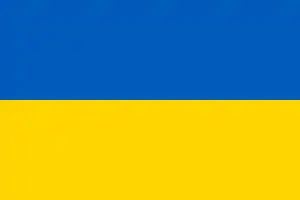 Ukraine (+380)
Ukraine (+380) - 1997 -
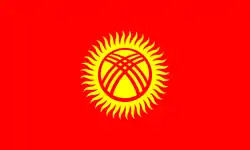 Kyrgyzstan (+996),
Kyrgyzstan (+996), 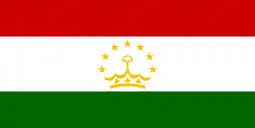 Tajikistan (+992),
Tajikistan (+992), - 1998 —
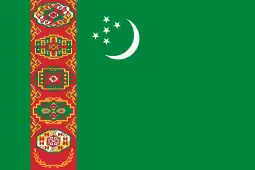 Turkmenistan (+993),
Turkmenistan (+993), 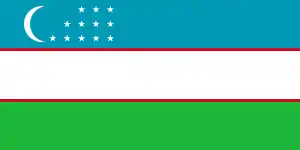 Uzbekistan (+998)
Uzbekistan (+998) - None -
 Kazakhstan and
Kazakhstan and  Russia (+7)
Russia (+7)
Area codes
Basically, area codes were distributed geographically, so that neighboring regions usually had close area code numbers.
Area 0
Area codes with 0 denotes the republics and Oblasts of the European part of the USSR. After the collapse of the Soviet Union, these codes in Russia, Belarus and Ukraine were preserved, with minor changes. Area codes in the Ukraine and Belarus later dropped initial 0. In Russia, in December 2005 the leading zero in the Oblastal area codes was replaced by a 4 with the next 2 numbers same (except Kaliningrad Oblast turning from 011 to 401 as 411 is in use).
|
|
Area 3
|
|
Area 4
- 411 - Yakut ASSR, Russian SFSR
- 413 - Magadan, Russian SFSR
- 415 - Kamchatka, Russian SFSR
- 416 - Amur Oblast, Russian SFSR
- 421 - Khabarovsk Krai, Russian SFSR
- 423 - Primorsky Krai, Russian SFSR
- 424 - Sakhalin Oblast, Russian SFSR
- 432 - Krasnovodskaya Oblast, Turkmenia
- 436 - Navoiy Region, Uzbekistan
Area 8
|
|
See also
- Telecommunications in Russia
- Telephone numbers in Russia
- Telephone numbers in the German Democratic Republic
- Telephone numbers in Poland
- Telephone numbers in Czechoslovakia (Czech Republic and Slovakia)
- Telephone numbers in Hungary
- Telephone numbers in Romania
- Telephone numbers in Bulgaria
- Telephone numbers in Cuba
- Telephone numbers in Mongolia
- Telephone numbers in Vietnam
References
- "Archived copy". Archived from the original on 2010-04-28. Retrieved 2010-04-28.CS1 maint: archived copy as title (link)
- "Archived copy". Archived from the original on 2008-06-25. Retrieved 2014-02-04.CS1 maint: archived copy as title (link)
- "Archived copy". Archived from the original on 2010-04-28. Retrieved 2010-04-28.CS1 maint: archived copy as title (link)